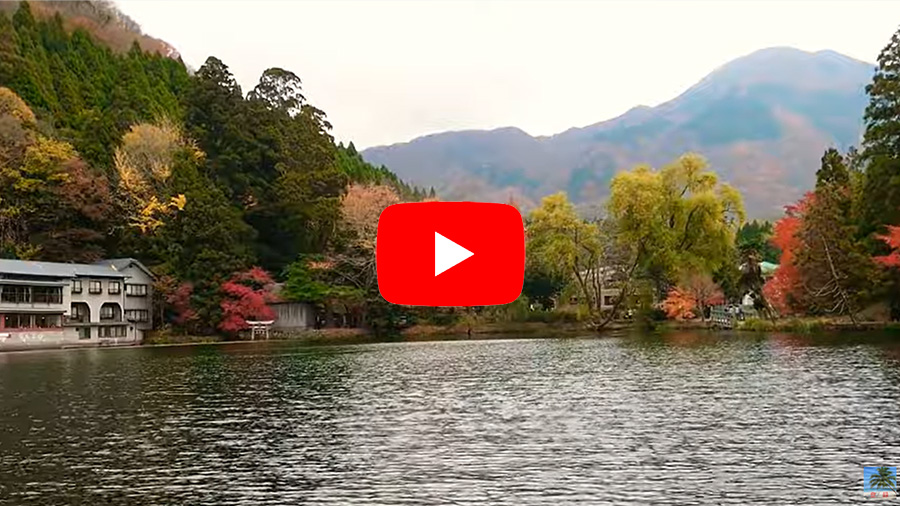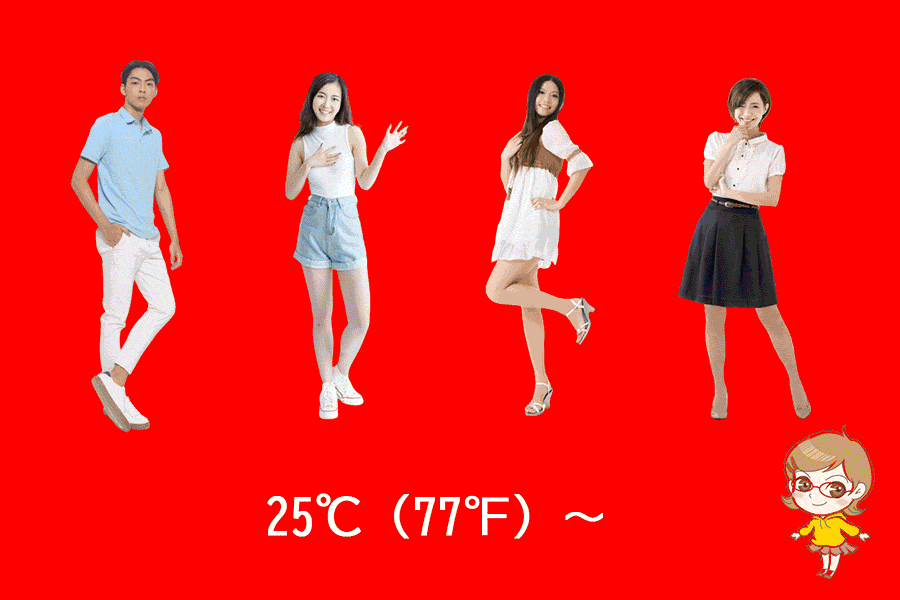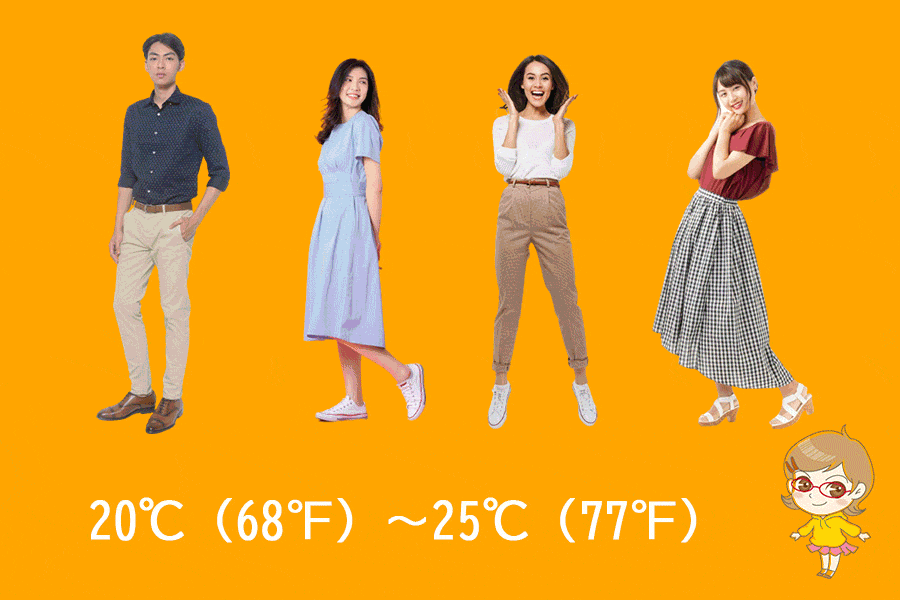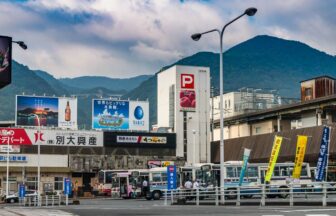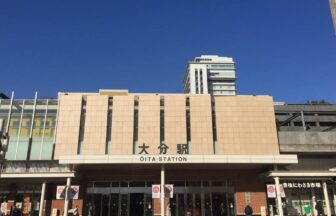8-2 Yufuincho Kawakita, Yufu, Oita 879-5114 MAP
↓ Click to jump to the relevant section.
| Current Weather | Annual Weather | Tourist Attractions |
| Baggage Deposit | Hotels |
Current weather and clothing
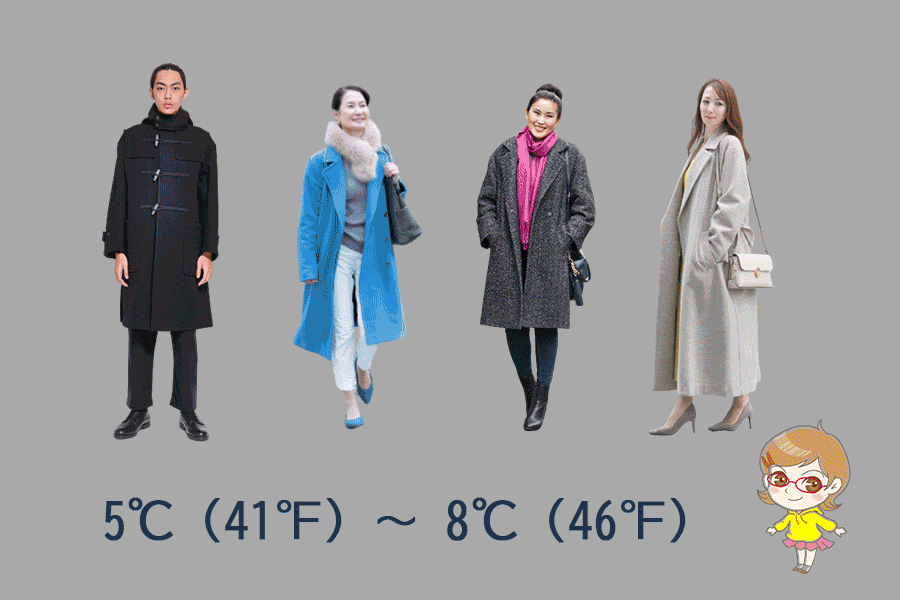
The weather information shown here is the information closest to the station in question. Please note that there may be slight differences.
Yearly temperature changes and recommended clothing
Clothing recommendations for each temperature range
When traveling in Japan with the following average temperatures, the recommended clothing is as follows:
Monthly changes in temperature, precipitation, and snowfall (1991~2020 average, Japan Meteorological Agency survey)
| Jan. | Feb. | Mar. | Apr. | May | Jun. | Jul. | Aug. | Sep. | Oct. | Nov. | Dec. | |
| temperature(°C) | 2.3 | 3.4 | 6.8 | 11.9 | 16.8 | 20.4 | 24.2 | 24.5 | 20.7 | 15 | 9.4 | 4.1 |
| precipitation(mm) | 59.2 | 76.1 | 109.6 | 121.5 | 153.4 | 362.9 | 355.2 | 240.9 | 264.6 | 117.3 | 76.1 | 55.4 |
| snowfall(cm) | — | — | — | — | — | — | — | — | — | — | — | — |
For Yufuin, the JMA does not publish archived data on snowfall.
Winter
December
In December, the temperature drops even further, with an average temperature of 4.1 degrees Celsius. It’s not uncommon for Yufuin Station to experience snowfall during this month. For men and women, it’s best to wear warm clothes such as thermal shirts and pants during the day. A warm jacket or coat is also recommended, especially for the evenings when the temperature drops below freezing. For footwear, it’s recommended to wear closed shoes or boots with warm socks to keep the feet warm. It’s also recommended to wear a hat, gloves, and a scarf to protect the head, hands, and neck from the cold weather.
January
January in Yufuin is the coldest month of the year with an average temperature of 2.3°C. It is a winter month with occasional snowfall. The precipitation is around 59.2 mm. For men and women, we recommend wearing winter clothing, including thick jackets, warm sweaters, long pants, and gloves to stay warm. It is also recommended to wear sturdy, waterproof boots to walk on snowy or slippery surfaces.
February
February in Yufuin is still a winter month but slightly milder than January with an average temperature of 3.4°C. There is occasional snowfall with the average precipitation of 76.1 mm. Similar to January, warm winter clothing is recommended for men and women. Wearing a scarf, hat, and earmuffs can help keep the neck, head, and ears warm. It is also essential to wear thick socks and warm shoes or boots.
Spring
March
March in Yufuin is the last winter month, and it becomes gradually warmer with an average temperature of 6.8°C. There may still be some occasional snowfall. The average precipitation is around 109.6 mm. For men and women, wearing a light jacket, sweater, and long pants with sturdy waterproof boots is recommended. A hat and gloves are also necessary for colder days.
April
April in Yufuin is the beginning of spring, with an average temperature of 11.9°C. The temperature rises significantly compared to March. The precipitation is around 121.5 mm. Light winter clothing, such as a light jacket or a sweater with long pants, can be worn. It is still chilly in the mornings and evenings, so keeping a light jacket or a cardigan handy can be useful.
May
May in Yufuin is a pleasant spring month with an average temperature of 16.8°C. The precipitation is around 153.4 mm. Men and women can wear light clothing such as T-shirts, short sleeves, or light sweaters with long pants. Wearing comfortable shoes is recommended for outdoor activities.
Summer
June
June in Yufuin is a warm and humid month with an average temperature of 20.4°C. Rainy days are common due to the rainy season until around mid-July. The precipitation is around 362.9 mm. Men and women can wear light and breathable clothing, such as shorts, skirts, and T-shirts, to stay comfortable in the heat. It is also recommended to wear comfortable sandals or shoes.
July
July in Yufuin, along with August, is one of the hottest months of the year, with an average temperature of 24.2°C. The precipitation is around 355.2 mm. Men and women can wear light and breathable clothing such as shorts, skirts, and T-shirts. It is recommended to wear sunscreen and sunglasses to protect the skin and eyes from the sun’s harmful rays. Wearing a hat is also useful to avoid direct sunlight.
August
August in Yufuin is another hot month, with an average temperature of 24.5°C. The precipitation is around 240.9 mm. Similar to July, men and women can wear light and breathable clothing such as shorts, skirts, and T-shirts, and it is essential to apply sunscreen regularly. Carrying a water bottle and staying hydrated is also essential.
Autumn
September
September in Yufuin is the beginning of autumn, with an average temperature of 20.7°C. The precipitation is around 264.6 mm. Men and women can wear light clothing such as light sweaters, shirts, and long pants. It is also recommended to carry a light jacket for cooler evenings.
October
At Yufuin Station, October brings even more signs of autumn. As the month progresses, the weather begins to cool down, but is still relatively mild, with an average temperature of 15°C. Precipitation is also relatively low, with an average monthly precipitation of 117.3 mm. For men and women, it is recommended to wear lightweight long-sleeved shirts or blouses and pants during the day. As the temperature may drop at night, it’s advisable to bring a light jacket or sweater. Closed shoes or sandals with socks are also recommended as it can still be warm during the day.
November
In November, the weather in Yufuin Station is much cooler, with an average temperature of 9.4 degrees Celsius. During this month, it’s recommended to wear warmer clothing. For men and women, it’s best to wear long-sleeved shirts or sweaters and pants or jeans during the day. Additionally, it’s best to bring a jacket or coat for the evenings as the temperature drops significantly. It’s also recommended to wear closed shoes or boots with socks to keep the feet warm.
Recommended tourist destinations
Mt. Yufu
Kawakami, Yufu 879-5102 Oita Prefecture
Yufudake, which rises 1,584 meters above sea level in the northeastern part of Yufuin, is popularly known as “Bungo Fuji” because of its beautiful and majestic appearance with twin-ear peaks. It is a popular mountain that attracts climbers all year round, and from its summit you can see the town of Yufuin, Beppu Bay, and the Kokonoe Mountain Range. It is also one of the few mountains where you can experience the “Brocken Phenomenon,” in which, when you stand with the sun at your back, your shadow is reflected in the clouds and fog ahead of you and a ring of colored light appears around it.
Lake Kinrin
Yufuincho Kawakami, Yufu 879-5102 Oita Prefecture
Lake Kinrin, with its mysterious steam rising from the surface of the lake, is one of Yufuin’s most popular tourist spots. The lake is surrounded by walking paths where you can watch fish and waterfowl swim by, making it a perfect place for a stroll.
Sagiridai Observatory
Yufuincho Kawakami, Yufu 879-5102 Oita Prefecture
Sagiridai” is a viewing spot from an elevation of 680 meters where you can enjoy a panoramic view of the town of Yufuin. The seasonal mountain views of Mt. Yufudake surrounding the observatory are wonderful, changing from spring to summer when the contrast between the mountains and the sky is beautiful, to autumn when golden silver grass sways in the air, and winter when the landscape is covered with snow. Especially in the early morning of winter, you can sometimes see a fantastic morning mist, as the name “Sagiri” suggests. There is also a store and restrooms at the observatory.
Yunotsubo Kaido
Kawakami, Yufu 879-5102 Oita Prefecture
Yunotsubo Kaido Road is located at the foot of Mt. Along the street, there are many souvenir stores selling Oita’s specialties such as yuzu gosho (yuzu citron pepper) and restaurants serving local delicacies such as toriten (chicken tempura), attracting many tourists. The Oita River, just off the street, is a recommended strolling spot where you can enjoy the scenery of each season.
Showa Retro Park Yufuin Showakan -ALWAYS-
1479-1 Yufuincho Kawakami, Yufu 879-5102 Oita Prefecture
At “Showa Retro Park Yufuin Showa-kan,” a 5-minute walk from Kinrin-ko, visitors can enjoy the nostalgic townscape and scenery of the Showa period. The retro Showa oil figurines are impressive on the exterior. There is also an old-fashioned candy store.
Kyushu Yufuin Folk Craft Village
1542-1 Kawakami, Yufuincho, Yufu 879-5102 Oita Prefecture
A collection of workshops, art/museum, and restaurants using old-fashioned buildings. Old buildings such as a sake cellar from the Meiji period (1868-1912), a stone cellar from Tsushima, and a gate from a residence of a family retainer have been relocated and used as workshops and restaurants.
Kokonoe Yume Otsurihashi Bridge
1208 Tano, Kokonoe-machi, Kusu-gun 879-4911 Oita Prefecture
The Kokonoe Yume Otsurihashi Bridge is 173 meters high and 390 meters long, making it the tallest suspension bridge in Japan for pedestrian use only. The view from the bridge is spectacular, offering views of “Shindo Falls,” one of the top 100 waterfalls in Japan, and “Kukenkei,” famous for its fresh greenery and autumn foliage. Especially in autumn, the bridge is a new favorite spot for viewing the autumn leaves, and is crowded with tourists in early November, when the leaves are at their best.
Mt.Tsurumi(Miyama Kirishima)
Tsurumidake is located at the eastern end of Aso Kujyu National Park. The ropeway runs from Beppu Kogen Station (500 meters above sea level) to Tsurumiyama-jojo Station (1,300 meters above sea level), and it takes less than 10 minutes to reach the top of the mountain. In spring, about 5,000 Miyama-kirishima and other rare plants are in full bloom on the mountain. In summer, it is about 10 degrees cooler than the flatlands, and at night, visitors can enjoy the vast “night view” of Beppu Bay.
Mamedamachi Shopping Street
Mamedamachi, Hita 877-0005 Oita Prefecture
Hita City, a heavenly domain, is also called Kyushu’s “little Kyoto. The town layout from the Edo period (1603-1868) remains intact, and the elegant streets are lined with souvenir shops, restaurants, and fashionable cafes. Kimono rental, rickshaw rides, and Japanese cultural experiences such as making temari and lanterns are also recommended.
Kuju Flower Park
4050 Kujumachi Kuju, Taketa 878-0201 Oita Prefecture
Located 850 meters above sea level in Aso Kujyu National Park, this is one of the largest healing flower gardens in western Japan, with 5 million flowers of 500 varieties blooming throughout the year. The park also has a restaurant, a gelato shop, a general store, a hands-on workshop, and many other stores.
Where to leave your luggage
Coin-operated lockers at Yufuin Station are located next to the restrooms 15 meters to the right as you exit the ticket gate.
There are not many coin lockers at the station, so if none are available, use the baggage storage facilities in the surrounding area.
When you exit Yufuin Station and go to the right, you will find the Tourist Information Center. Coin lockers and a baggage storage facility are located there. It is open from 9:00 to 17:00.
There is a souvenir shop “Hinoshin” across the street from the station. There are also coin lockers and a baggage storage area there.
Recommended hotels and inns
Yufuinsanso Waremoko
589 Yufuincho Kawaminami, Yufu 879-5103 Oita Prefecture
15-minutes walk from Yufuin Station
Hotel class: 5
Hotel style: Romantic , Charming
Check Rates & Availability:
>> See on Tripadvisor
>> See on Trip.com
>> See on Expedia
Yufuin Onsen Hinoharu Ryokan
1082-1 Yufuincho Kawakami, Yufu 879-5102 Oita Prefecture
11-minutes walk from Yufuin Station
Hotel class: 4
Hotel style: Quaint , Family
Check Rates & Availability:
>> See on Tripadvisor
>> See on Trip.com
Yufuin Santokan
1553 Yufuincho Kawakami, Yufu 879-5102 Oita Prefecture
15-minutes walk from Yufuin Station
Hotel class: 4
Hotel style: Classic, Charming
Check Rates & Availability:
>> See on Tripadvisor
>> See on Trip.com
>> See on Expedia
Sanso Murata
1264-2 Yufuincho Kawakami, Yufu 897-5102 Oita Prefecture
1.2mi/1.9km from Yufuin Station
Hotel class: 4
Hotel style: Luxury , Classic
Check Rates & Availability:
>> See on Tripadvisor
>> See on Trip.com
Yufuin Hanayoshi
913-11 Yufuincho Kawakita, Yufu 879-5114 Oita Prefecture
1.3mi/2.1km from Yufuin Station
Hotel class: 4
Hotel style: Mountain View , Luxury
Check Rates & Availability:
>> See on Tripadvisor
>> See on Trip.com
>> See on Expedia
Ryu no Hige / Bettei Yumuta
1253-8 Yufuincho Kawanishi, Yufu 879-5113 Oita Prefecture
2.8mi/4.5km from Yufuin Station
Hotel class: 4
Hotel style: Romantic , Luxury
Check Rates & Availability:
>> See on Tripadvisor
>> See on Expedia
Musouen
1243 Yufuincho Kawaminami, Yufu 879-5103 Oita Prefecture
14-minutes walk from Yufuin Station
Hotel class: 3.5
Hotel style: Classic , Mountain View
Check Rates & Availability:
>> See on Tripadvisor
>> See on Trip.com
>> See on Expedia
Yufuin Hotel Shuhokan
2415-2 Yufuincho Kawakami, Yufu 879-5102 Oita Prefecture
10-minutes walk from Yufuin Station
Hotel class: 3
Hotel style: Family
Check Rates & Availability:
>> See on Tripadvisor
>> See on Trip.com
>> See on Expedia
Yufuin Yawaraginosato Yadoya
2717-5 Yufuincho Kawakami, Yufu 879-5102 Oita Prefecture
12-minutes walk from Yufuin Station
Hotel class: 3
Hotel style: Great View , Charming
Check Rates & Availability:
>> See on Tripadvisor
>> See on Trip.com
>> See on Expedia
Baien
2106-2 Yufuincho Kawakami, Yufu 879-5102 Oita Prefecture
18-minutes walk from Yufuin Station
Hotel class: 3
Hotel style: Great View , Charming
Check Rates & Availability:
>> See on Tripadvisor
>> See on Trip.com
>> See on Expedia
We support your itinerary planning!
Click the button to get an overview of hotel information and popular tourist routes from all over Japan featured on our site. We’ve included comprehensive details to aid in planning your trip, so please make use of it.
Comprehensive checklist before traveling to Japan

Book flights
Compare and purchase flight tickets
When planning your trip to Japan, it's advisable to start by researching flights several months in advance. Airlines often release promotional fares, especially during off-peak seasons. Use comparison sites like Skyscanner or KAYAK to get a sense of the price range. Be flexible with your travel dates if possible; flying mid-week might be cheaper than on weekends.
>> Visit Skyscanner's official website
>> Visit KAYAK's official website
Order Japan Rail Passes for each family member
Purchase your Japan Rail Pass before departure
The Japan Rail (JR) Pass offers unlimited travel on JR trains, making it a cost-effective option for tourists. However, it's only available to foreign tourists and must be purchased *before* you arrive in Japan. Determine the areas you plan to visit; if you're traveling extensively, a nationwide pass is beneficial, but if you're only exploring a specific region, consider regional JR passes. Children under 12 get a discounted pass, so ensure you order the correct type for each family member.
>>Visit Japan Rail Pass's website
Plan your attire for Japan
Check the weather at your destination on this site
Japanese weather varies significantly by season. In summer, it's hot and humid, so breathable clothes are essential. Winters, especially in the north, can be cold, requiring warm attire. If visiting during the rainy season (June to early July), pack a good umbrella and waterproof shoes. While Japan is generally casual, certain places like temples, shrines, or upscale restaurants may require modest and neat dressing.
Reserve a pocket Wi-Fi or SIM card

SIM card or pocket Wi-Fi is required
Beyond clothes, consider packing essentials like a universal power adapter (Japan uses Type A and B sockets), portable Wi-Fi or SIM card for internet access, and any necessary medications (with a copy of the prescription).
Which is better: a SIM card or pocket Wi-Fi?
When traveling in Japan, one essential to consider is securing internet access, especially given that many locations still don't offer free Wi-Fi. To ensure you can use your smartphone throughout your trip, you'll typically have three options: (1) a SIM card, (2) pocket Wi-Fi, or (3) the roaming service provided by your mobile company. Roaming services can be quite expensive, so we often recommend using a SIM card or pocket Wi-Fi. While SIM cards tend to be more affordable than pocket Wi-Fi, they can be trickier to set up. Pocket Wi-Fi, on the other hand, can be shared among several users, making it a favorable choice for families or groups.
▼SIM card
Advantages:
Relatively affordable.
Disadvantages:
Can be time-consuming to set up initially.
May have strict data limits.
▼Pocket Wi-Fi
Advantages:
Offers substantial data allowances.
A single device can be shared among multiple users.
Easily usable with PCs as well.
Disadvantages:
Typically more expensive.
Japan's representative services

Sakura Mobile's website
▼SIM card
>>Visit Sakura Mobile's official website
>>Visit mobal's official website
▼pocket Wi-Fi
>>Visit Sakura Mobile's official website
>>Visit NINJA WiFi's official website
>>Visit Wi-Fi RENTAL Store's official website
Book local tours as needed
Pre-book your tour and have a great trip!
Local tours offer deep insights into Japan's culture and heritage. Websites like Viator or GetYourGuide offer a variety of tours, from traditional tea ceremonies to modern pop culture tours in Akihabara. Consider unique experiences like staying with monks on Mt. Koya or taking a cooking class to learn authentic Japanese dishes.
>>Visit Viator's official website
>>Visit GetYourGuide's official website
Purchase advance tickets for popular attractions
Make a reservation to avoid crowds
Attractions like Tokyo Disneyland, Universal Studios Japan, or the Studio Ghibli Museum often have long ticket queues. Buy tickets online in advance to save time. Some attractions also have timed entry, so check the specific time slots available and plan accordingly.
▼Tokyo Disney Resort
>>Visit Tokyo Disney Resort official website
>>Visit Viator's Tokyo Disneyland page
>>Visit Viator's Tokyo DisneySea page
>>Visit GetYourGuide's Tokyo Disneyland page
>>Visit GetYourGuide's Tokyo DisneySea page
▼Universal Studios Japan
>>Visit USJ official website
>>Visit Viator's USJ page
>>Visit GetYourGuide's USJ page
Buy travel insurance

insurance concept, health, life and travel insurance
It is important to be prepared for emergencies
While Japan is a safe country, travel insurance is crucial for unforeseen events like health emergencies, travel disruptions, or lost baggage. Ensure your policy covers medical expenses in Japan, as healthcare, though excellent, can be expensive.
Here we introduce online travel insurance services that are popular worldwide.
World Nomads: An online travel insurance service widely endorsed by travelers worldwide. They offer plans that cover adventurous activities and high-risk sports.
>>Visit World Nomads' official website
AIG Travel Guard: An insurance service available to travelers all over the world. They offer a wide range of options, including cancellation protection and emergency medical insurance.
>>Visit AIG Travel Guard's official website
Share your itinerary with emergency contacts
Organize your reservation information
Keep a digital and printed copy of your detailed itinerary, including hotel addresses, train schedules, and booked tours. Share this with a trusted family member or friend not traveling with you.


